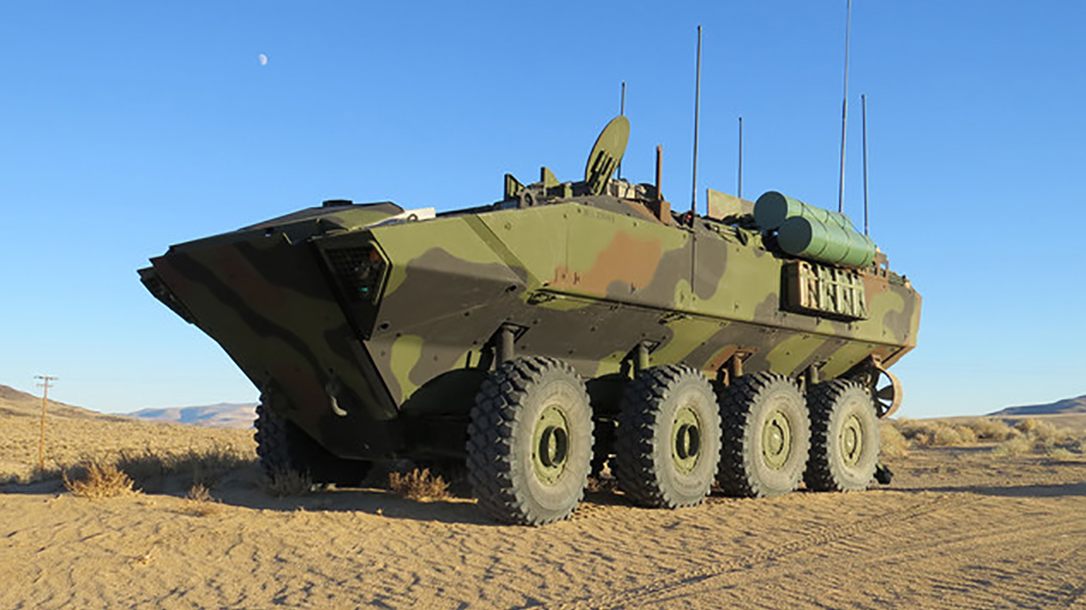In 2011, the U.S. Marine Corps sent out a RFI to industry for a new Amphibious Combat Vehicle (ACV) to replace its aging Assault Amphibious Vehicle (AAV). Fast forward seven years, and BAE Systems has been awarded the contract to produce the ACV.
The Contract
Marine Corps Systems Command says the deal is worth $198 million. It calls for BAE to build 30 low rate production ACV 1.1 vehicles. According to Military.com, additional contract options could raise the value of the deal to $1.2 billion.
Advertisement — Continue Reading Below
Amphibious Combat Vehicle
As the USMC news release notes, the ACV is an eight-wheeled vehicle that provides protection akin to the MRAP. Its landward maneuverability and mobility is allegedly superior to that of the AAV. When fielded, it’ll be equipped with a precision weapons station. It’ll also have a “robust swim capability, allowing it to operate within the littorals and beyond,” the service says.
“The ACV provides a mobile capability that mechanizes the force to maintain tempo with the remainder of the [Marine Air-Ground Task Force]; specifically the M1A1 tank,” said Col. Kirk Mullins, ACV 1.1 product manager in Program Manager Advanced Amphibious Assault in PEO Land Systems. “It isn’t maintenance intensive because of its increased reliability, and it also provides greater protection against threats we encounter on the battlefield.”
ACV Testing
According to Military.com, BAE was one of two companies the Corps picked in 2015 to build 16 ACV 1.1 prototypes for testing. The other company was SAIC (Science Applications International Corporation), which teamed with Singapore Technologies Kinetics.
Advertisement — Continue Reading Below
Testing was then done over a two year period at U.S. Army Aberdeen Test Center in Maryland; the Amphibious Vehicle Test Branch aboard Camp Pendleton, California; the Yuma Test Center in Arizona; the U.S. Army Engineer Research and Development Center in Mississippi; and the White Sands Missile Range Army Base in New Mexico. BAE emerged as the winner.
“Today, after a rigorous and thorough test and evaluation period of two competing prototypes, we are taking another major step in fielding that much-needed capability to our Marines,” said John Garner, PEO for Land Systems.
“Our test program was exhaustive in an effort to ensure we gathered all the data needed to make the best decision,” said Mullins. “We tested the ACV for survivability, mobility, water operations and reliability, and completed gunnery testing.”
Advertisement — Continue Reading Below
AAV
The Corps says the AAV has been in service for over four decades. As such, its components and parts have been rendered obsolete. This creates headaches for the service in terms of maintaining the vehicle. That, coupled with the fact that Marines now have to deal with IEDs, produced a need for a more “survivable combat vehicle” that can move from ship to shore and beyond.
“In order to be a step ahead of our adversaries in the future, the Marine Corps needed to find a modern vehicle at an affordable price range that provided significant capability enhancement and performance over the AAV,” Mullins said.
ACV Timetable
The USMC is set to buy 204 ACV 1.1 vehicles in phase one of the effort to replace the AAV. Phase two will be the development of the ACV 1.2, an upgraded version of the ACV 1.1 the Corps hopes will replace the current fleet of 870 AAVs.
Advertisement — Continue Reading Below
Delivery on the ACV 1.1 is expected to begin in the fall of 2019. I Marine Expeditionary Force will be the first to get the new ACV. Fielding starts in the fourth quarter of 2020. Full operational capability is scheduled for 2023.


























